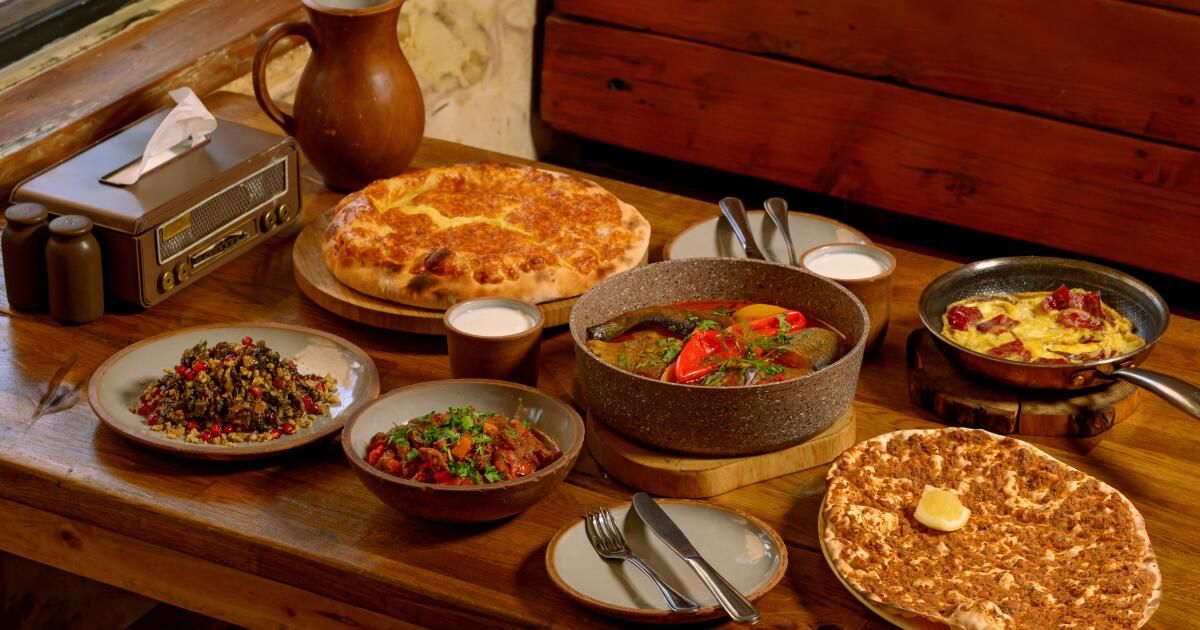The main raffle in Tun Lahmajo, a restaurant in bubank bounded with granulated forests to resemble a summer cabin, is there in the name. A mottled and golden edges lands at almost all table, or maybe three or four of them, for each person in a group.
In the Levantine Arab, the dish is known as the Bi Ajeen: literally, “flesh with dough”. The Armenians shortened the phrase and adapted the flat bread as theirs. The chefs in Tun Lahmajo stretch their harinista palette almost as thin as a water cookie, although the taste has much more coal and spike. Kitchen stain in a mixture of silky meat of beef seasoned and tomato paste directly to the edge, which often farter generously in the heat of the baking.
They can arrive oval, or more round, or somewhere oblong and in the middle. Its unpredictable beauty is a reminder that a real human of someone is in the kitchen that molds them. Always, a server hasten them directly from the oven, when they are both crispy and folded, in dishes where the crunchy circumference hangs just on the edge. A square lemon wedge has been dropped in the center of Lahmajo. Rocio of juice on the surface cuts the concentrated flesh. Many customers request additional citrus.
I could stop here, and it would be enough as a recommendation. The firm in Tun Lahmajo, consistent and excellent, has already been adopted by the Armenian community of Los Angeles, the largest population of the diaspora out of Armenia. They keep the place busy.
However, in the months since the restaurant opened last summer, the menu has expanded, to the point that it can be addressed in two ways: as a list of comforting foods and as a door in the long and intricate story of a kitchen.

Lahmajo enters the oven. The newly baked and Megrelakan Khachapuri. (Angelis Ron / for the Times)
To continue with the topic of bread a little longer: a single variation of Lahmajo is available, with cheese. But Khachapuris hedonistically cheesy – specialties of the Republic of Georgia, which borders Armenia to the north – they take my attention away.
Adducrian Khachapuri, the decreased version at the ends to resemble a canoe, will be remembered by food obsessives for the time at the end of the last decade. The cheese fills its helmet; After baking, the cook laughs on one or two eggs with butter palmadites to exaggerate wealth. Combine everything with a spoon and voul: molten sauce in a bread bowl.
To make the Khachapuri Megrelakan (sometimes called Megreliano), eggs and butter bend in grated and elastic sulguni cheese before cooking. This is the jewel. The servers are staggering by the dining room, deflating themselves as a souffle, and then divided it into sixth on the table with a pizza wheel. Hot and irresistible, the texture is undulating, compensated by crispy and blistering stripes. As the mottled cake cools and its ingredients settle and condense, an attractive and salty and salty becomes more open.

Fish Khashlama is located in the center of an extension of dishes.
(Angelis Ron / for the Times)
The tasty breads have been the focus from the beginning, when Eduard Janibekyan and his family opened the first tun Lahmajo in Ereván, the capital of Armenia, in 2008.
The best Armenian restaurants in Los Angeles tend to excel in a fort: the exquisite marinated meats and the grill in the Mini Kabob; Mulchy's pleasures of flat bread full of vegetables in Hatz Zhengyalov Hatz; The cured meat, with a tip, packed in sandwiches in Sahag Basturm. That, or serve the Lebanese-Armenian menus that date back to the old community of the diaspora in Beirut. Currently, the best among our Lebanese-Armenian institutions is the advanced Hollywood position of the carousel.

Mary Janibekyan and Arsen Sardaryan with her son Vahagn, part of the family behind Tun Lahmajo.
(Angelis Ron / for the Times)
Very few local places deepen the regionally specific Armenian repertoire, what the son of Janibekyan, Vladislav defined in an interview as “Caucasian cuisine”, which refers to the geographical area located between the black seas and marries defined widely as the Caucasus.
The classification of Armenian food roots must take into account the sequelae of the genocidal murder of more than 1 million Armenians from 1915, and almost 70 years under the Soviet regime that followed closely in 1991. The country without signs, which borders Turkey and Iran towards the West, has been a cross of failures for the millennia.
“Cultural and gastronomic exchange has been an integral part of this region during the centuries … Armenians do not have a national cuisine in the same sense as the nationalities that possessed a long history of status and well -defined borders,” wrote Irina Petrosian and David Underwood in their 2006 book, “Armenian Food: FACT, Fiction & folklore.” For the example of Lahmajo, the authors pointed to the repatriated Armenians in the 1960s who returned from the Syrian city of Aleppo as those who introduced the dish to Ereván.
How do you inform all this complex story a meal in bubank?


1. Tun Lahmajo has already been accepted by the Armenian community of Los Angeles, the largest population of the diaspora outside Armenia. (Angelis Ron / for the Times)
Order a tense yogurt start, its density somewhere between the mascarpone and the cream cheese, for touching on torn pieces of thehmajo and bring jiltness to meats as roasted lambs roasted in the oven. I love the way Qrchick, a reddish soup shaking with a runoff cabbage, cuts the richness of the Khachapuris.
A plate of beef and slightly seasoned sauteed potatoes, both cut into strips, has been made by Armenian chefs for so long that no one can identify the origin of their nickname. It is called “Ker u his”, which translates colloquially as “shut up and eat.” If the combination does not directly progress its nostalgia, its inquisitive palate can be more agitated by Ostri, rescue meat with garlic with dry red chiles and phenogreco. Avanouk, a tangle of wild oedories served fresh and adorned with crushed nuts, brings an infusion of green to the mixture.
Khashlama is a category of broth stews. An elementary variation made with lamb in a wobble in Bland, but the generous -size fish khashlama is a summer joy, taken in a pot with pieces of trout (bone surveillance), peeled potatoes and whole peppers, and is placed with dill, parsley and other feather herbs.

Avanouk is served fresh with a wild accelerate tangle served fresh and adorned with crushed nuts.
(Angelis Ron / for the Times)
If you can accelerate your lunch or dinner with leisure, request the traditional and endearing universal chmur: russets roasted in the oven for 40 minutes and then at the smooth tables, along with a lot of butter, by a server that wielded a wooden crusher.
It could run through other rabbit holes, including Kebabs's Levantine tones, Shawarma, Ishli (known elsewhere as Kibbeh) and a heavy riff of Bulghur in Tabobouleh or Borscht and oil color pilaf, Uzbekistani style to advance the values of the sofiest era. The menu is discouraging, and against the many other prominent aspects of these options each rate well enough.
There will probably be little space for dessert, but I must point out the cat, a hot round pastel cake hybrid that hides a layer of custard cream just below the upper cortex. One could discuss the empires and authenticity about a spread in tun lahmajo, or take their moving cooking to the letter, but in the end an outstanding meal concludes as it should begin: with a thing tanned with beauty that heats up from the oven.
Tun Lahmajo
2202 N. Genoaks Blvd., Burbank, (626) 553-8717, Instagram.com/tunlahmajo.usa
Prices: Sabrous Armenians Armenian Flatbreads and Bread of Cursis from $ 6.80 to $ 25, soups from $ 12 to $ 14, salads from $ 9 to $ 15, meats and stews from $ 23 to $ 39, desserts from $ 7 to $ 18.
Details: Open every day, from 10 am to 10 pm, there is no alcohol (but try the herbal tea of the “Armenian bouquet”). Lot and street parking.
Recommended dishes: Lahmajo, Megrelakan Khachapuri, Fish Khashlama, Ostri (spicy beef), yogurt tension, aveolouk (vegetables with nut and grenade), cat (sweet pastry hybrid).

A diorama of the Janibekyan family house in Armenia is perched on a corner on the wall of Tun Lahmajo.
(Angelis Ron / for the Times)












